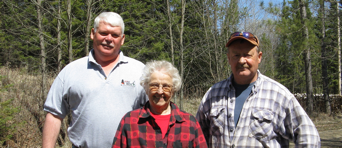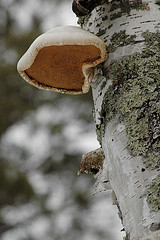Posts tagged ‘firewise’
Itasca County Chipper Days: Neighbors helping neighbors
By Julie Miedtke, University of Minnesota Extension-Itasca County
Alice Martwig owns a little piece of heaven with a residence on Graves Lake located in the Suomi Hills area north of Grand Rapids. When I met her in the driveway, earlier in May, she gave a warm welcome and quickly showed me to the work being completed near her home. Alice was pleased with her growing pile of brush and limbs near the driveway and she was quick to point out a small pile of firewood stacked near the sauna. Alice mentioned that the catalyst for the project was attending Firewise workshop and acknowledged the need to remove some vegetation in order to help make her home a safer place to live.

Bill Brink-Itasca County Firewise Coordinator with Alice Martwig and Norm Ford.
Norm Ford is a Firewise advocate and recruited neighbors Curtis Dahleen, Dale Juntunen, Mike Bellomy to help Alice prune up lower limbs and carry it out to a designated spot along the driveway. Ford has helped several neighbors in the Suomi Lakes area tackle projects this spring. Woody vegetation that is being piled along driveways and roadsides will soon be collected by Deer River Hired Hands, a non-profit organization and hauled to Minnesota Power’s Rapids Energy Center in Grand Rapids and used to generate energy.
Firewise Your Deer Shack!
Over the past few months, Bill Brink-the Itasca County Firewise Coordinator organized members of the Rural Fire Departments to help homeowners identify potential hazards and risks. After visiting over 5,400 homes, cabins and deer shacks it is obvious that Itasca County has an expanding wildland-urban interface which places more demands on everyone that delivers emergency services.
The Itasca County Wildfire Protection Implementation Team has recently been awarded a DNR-Firewise grant to help seasonal residents and homeowners reduce risks on their property. A portion of the grant allowed Brink to train vendors who can help homeowners with projects like improving defensible space around structures, driveways, removing dead or unwanted trees, or being sure the propane tank is set up safely being placed on gravel. The grant also supports the Chipper Day Program by covering the costs of hauling woody vegetation to the Rapids Energy Center that will use the material to generate renewable energy.
To help make an effective program, we are looking to organize neighborhoods and collections point to make help make hauling more efficient. If you have been working in your yard this spring and have a large pile of brush and limbs, or if you have been clearing vegetation to build a garage or your dream home, consider having your hazardous woody vegetation hauled by the Chipper Day Program. It may be a safer option than burning a pile in your backyard. The program expires on September 30, 2009.
Would you like to learn more?
For more info, visit the Itasca County Firewise Program website. Or consider attending the next Itasca County Community Wildfire Protection Implementation Team meeting is scheduled for Tuesday, June 9, 2009 from 10:00 to 12:00 p.m. at the Itasca County Courthouse. For more information contact Itasca County Extension at 218-327-7365 or Bill Brink at 218-360-1114.
Woodland wildfire and protecting your property
Forest fires are classified as surface, crown, or ground fires based on their manner of spread. Most forest fires in the Midwest are surface fires. They burn only the litter and other small fuels on the forest floor. They may scar the base of large trees and kill small trees.
Continue Reading April 29, 2007 at 2:29 pm esagor Leave a comment


Recent comments